Nuraghe Antigori  Nuraghe Antigori |
|
| Type | Monument |
|---|
|
| Cultures | Nuragic civilization |
|---|
|
| Excavation dates | yes |
|---|
| Condition | ruined |
|---|
| Management | I Beni Culturali della Sardegna |
|---|
| Public access | yes |
|---|
The Nuraghe Antigori is a nuragic complex dating back to the second millennium BC. It's located in the municipality of Sarroch, in the Metropolitan City of Cagliari.
The site was built on a rocky peak called Antigori, on which the remains of several towers are scattered, most of which are in poor state of preservation; the only visitable one in its interior is the tower C, with the classic tholos coperture. A small, almost intact, wall and the foundations of the huts that formed a small village are still observable.
The complex was excavated in 1982 by Maria Luisa Ferrarese Ceruti and in 1994 by Roberta Relli. The excavations returned various nuragic and Mycenaean pottery (from Argolis, Crete, and Cyprus [1] ) dating back to the 14th-13th and 13th-12th century BC, a testimony of the important exchanges that took place between the Nuragic civilization and the Mycenaean civilization.
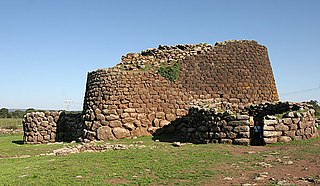
The nuraghe or nurhag is the main type of ancient megalithic edifice found in Sardinia, developed during the Nuragic Age between 1900 and 730 B.C. Today it has come to be the symbol of Sardinia and its distinctive culture known as the Nuragic civilization. More than 7,000 nuraghes have been found, though archeologists believe that originally there were more than 10,000.

Olbia is a city and commune of 60,346 inhabitants in the Italian insular province of Sassari in northeastern Sardinia, Italy, in the historical region of Gallura. Called Olbia in the Roman age, Civita in the Middle Ages and the Terranova Pausania until the 1940s, Olbia has again been the official name of the city since the fascist period.

Archaeological evidence of prehistoric human settlement on the island of Sardinia is present in the form of nuraghes and other prehistoric monuments, which dot the land. The recorded history of Sardinia begins with its contacts with the various people who sought to dominate western Mediterranean trade in classical antiquity: Phoenicians, Punics and Romans. Initially under the political and economic alliance with the Phoenician cities, it was partly conquered by Carthage in the late 6th century BC and then entirely by Rome after the First Punic War. The island was included for centuries in the Roman province of Sardinia and Corsica, which would be incorporated into the diocese of Italia suburbicaria in 3rd and 4th centuries.
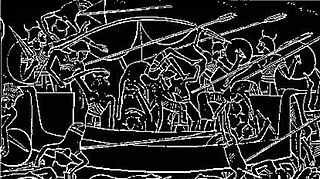
The Sherden are one of the several ethnic groups the Sea Peoples were said to be composed of, appearing in fragmentary historical and iconographic records from the Eastern Mediterranean in the late 2nd millennium BC.
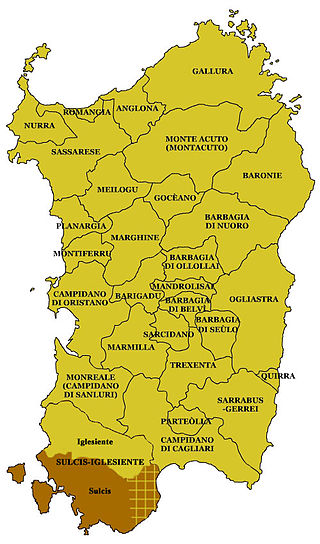
Sulcis is a subregion of Sardinia, Italy, in the Province of South Sardinia.

The Nuragic civilization, also known as the Nuragic culture, was a civilization or culture on Sardinia (Italy), the second largest island in the Mediterranean Sea, which lasted from the 18th century BC up to the Roman colonization in 238 BC. Others date the culture as lasting at least until the 2nd century AD and in some areas, namely the Barbagia, to the 6th century AD or possibly even to the 11th century AD.

The Bonnanaro culture is a protohistoric culture that flourished in Sardinia during the 2nd millennium BC, considered to be the first stage of the Nuragic civilization. It takes its name from the comune of Bonnanaro in the province of Sassari where in 1889 the eponymous site was discovered.
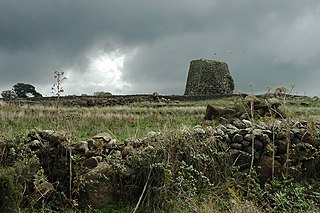
Paleo-Sardinian, also known as Proto-Sardinian or Nuragic, is an extinct language, or perhaps set of languages, spoken on the Mediterranean island of Sardinia by the ancient Sardinian population during the Nuragic era. Starting from the Roman conquest with the establishment of a specific province, a process of language shift took place, wherein Latin came slowly to be the only language spoken by the islanders. Paleo-Sardinian is thought to have left traces in the island's onomastics as well as toponyms, which appear to preserve grammatical suffixes, and a number of words in the modern Sardinian language.

The Giants of Mont'e Prama are ancient stone sculptures created by the Nuragic civilization of Sardinia, Italy. Fragmented into numerous pieces, they were discovered in March 1974 on farmland near Mont'e Prama, in the comune of Cabras, province of Oristano, in central-western Sardinia. The statues are carved in local sandstone and their height varies between 2 and 2.5 meters.
Giovanni Lilliu, was a renowned archeologist, academician, publicist and politician and public figure and an expert of the Nuragic civilization. Largely due to his scientific and archeologic work in the Su Nuraxi di Barumini in Sardinia, Italy, the site was inscribed on the UNESCO list of World Heritage Sites in 1997.

Santu Antine, also known as Sa domo de su re is a nuraghe in Torralba, one of the largest in Sardinia. It is located in the centre of the Cabu Abbas plain. The main structure was built around the 19-18th century BC, and the other parts of the nuraghe date back to the 17th–15th century BC. The main tower originally reached a height of 23–24 metres and contains three tholoi chambers on top of each other. The central tower with diameter of 15 metres is 17 metres high. Santu Antine is made of huge basalt blocks. It has three floors. The top floor is now gone. Some 27 meters long corridors built with the corbel arch technique can be observed inside of the Nuraghe, superimposed on two floors, the Nuraghe was provided with three wells.
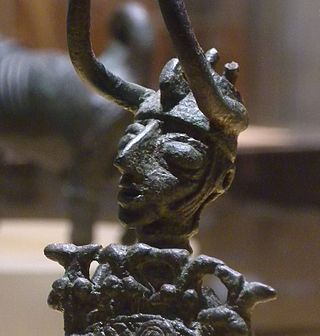
The Nuragic bronze statuettes are typical Nuragic Sardinian bronze sculptures of the final phase of the Bronze Age and the early Iron Age.

The nuragic holy well is a typical Sardinian hypogean Bronze Age structure for the worship of the waters. Scattered throughout the island, along with the Giants' grave and the megaron temples, they testify to the deep religiosity of the Nuragic populations. These temples were a place of pilgrimage and ceremonies: it is believed that at certain times of year the various nuragic populations of the area gathered together in their vicinity.

The nuraghe Seruci is an important archaeological site, located in the municipality of Gonnesa, in the Iglesiente region of Sardinia.

The nuraghe Is Paras is an archeological site of Isili, a town in the historical region of Sarcidano, province of South Sardinia.

The necropolis of Is Loccis-Santus is an archaeological site located in the municipality of San Giovanni Suergiu, Sardinia.
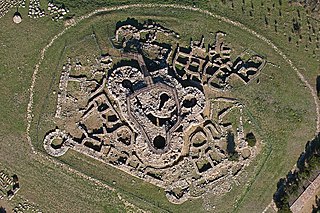
The nuraghe Genna Maria is an archaeological site in the comune of Villanovaforru, province of South Sardinia.

The Nuragic sanctuary of Santa Vittoria is an archaeological site located in the municipality of Serri, Sardinia – Italy. The name refers to the Romanesque style church built over a place of Roman worship which rises at the westernmost tip of the site. The Santa Vittoria site was frequented starting from the first phase of the Nuragic civilization corresponding to Middle Bronze Age. Subsequently, from the late Bronze Age to the early Iron Age, the place became one of the most important expressions of the Nuragic civilization and today it constitutes the most important Nuragic complex so far excavated.

The history of Phoenician and Carthaginian Sardinia deals with two different historical periods between the 9th century BC and the 3rd century BC concerning the peaceful arrival on the island of the first Phoenician merchants and their integration into the Nuragic civilization by bringing new knowledge and technologies, and the subsequent Carthaginian presence aimed at exploiting mineral resources of the Iglesiente and controlling the fertile plains of the Campidano.


















